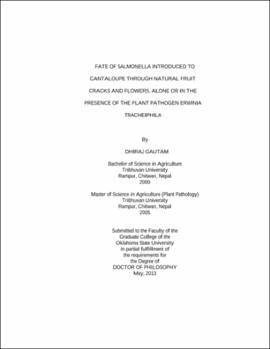| dc.description.abstract | Salmonella-tainted cantaloupe has been implicated in foodborne illnesses. We know little about Salmonella ecology on cantaloupe flowers and fruits, and chose to investigate whether it can enter edible tissues, and whether its interactions with other microbes influence its fate. We assessed the survival and potential internalization of S. enterica and the wilt bacterium, Erwinia tracheiphila, on cantaloupe after fruit surface or flower inoculation. S. enterica, E. tracheiphila, or a mixture of the two (10^7 cfu/ml) were introduced onto natural rind cracks or into the flower whorl. Inoculated rind and sub-rind mesocarp were sampled at 0, 9 and 24 days post-inoculation (DPI). Flower samples were collected at 0 and 43 DPI, and interior mesocarp at 15 and 43 DPI. S. enterica survived on 40% and 14% of cantaloupe rinds inoculated with both pathogens, or S. enterica only, respectively. 58% of E. tracheiphila inoculated samples developed watersoaked lesions on rinds. Unlike S. enterica, E. tracheiphila traversed some fruit cracks and 31% of sub-rind mesocarps were positive at 24 DPI. At 0 and 43 DPI all blossom samples receiving S. enterica alone, or the mixture, were positive for S. enterica. At 43 DPI, the populations of S. enterica were significantly (P<0.05) higher than these at 0 DPI from 4.46 to 6.12 log cfu/ ml and 4.89 to 6.86 log cfu/ml, respectively. E. tracheiphila was never detected after day 0. A mesocarp sample from one fruit, flower-inoculated with S. enterica only, was positive for this bacterium. The results suggest that S. enterica can survive on the rind until fruit maturity. E. tracheiphila can traverse the cracked rind, causing watersoaking of interior tissues; the leakage of cell contents can enhance S. enterica survival on the fruit surface. Fruit contamination after flower inoculation with S. enterica was a rare event under our conditions, but flowers can harbor the bacteria until fruit maturity, thereby becoming a potential reservoir. Use of agricultural practices minimizing fruit contact with potentially contaminated substrates could reduce the risk of Salmonella contamination. | |
